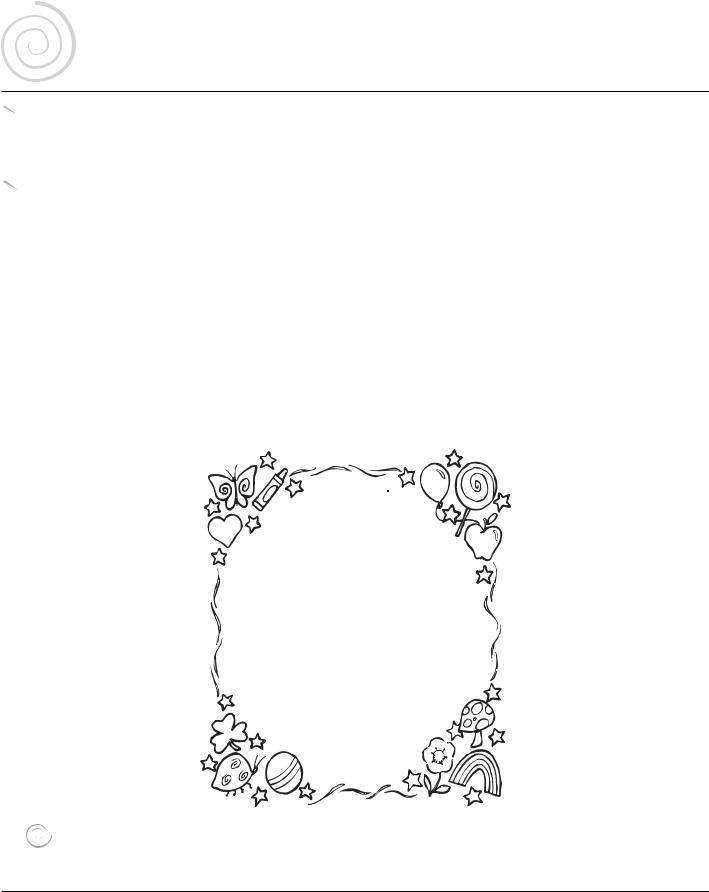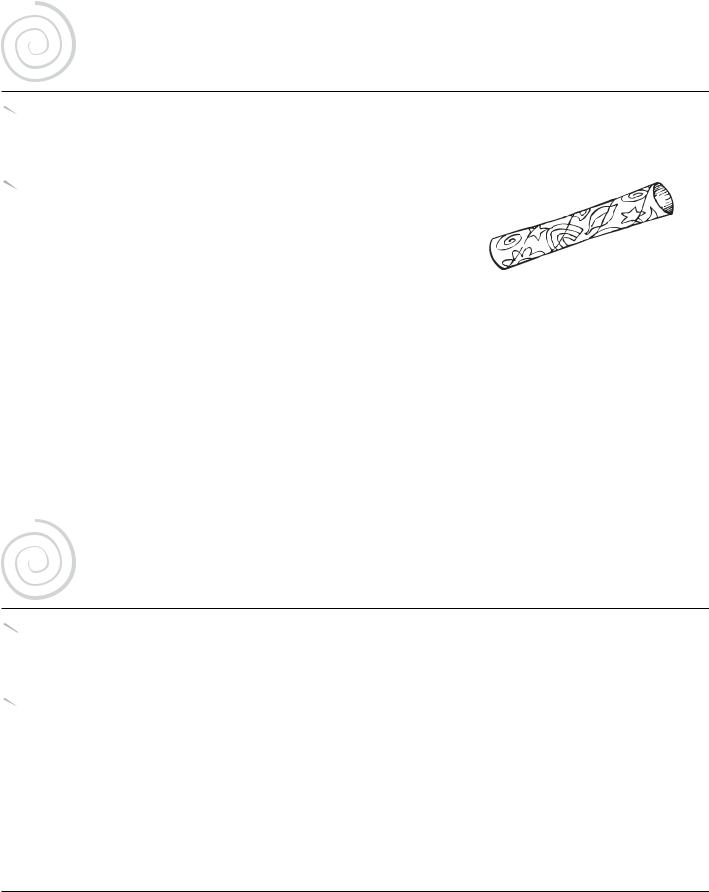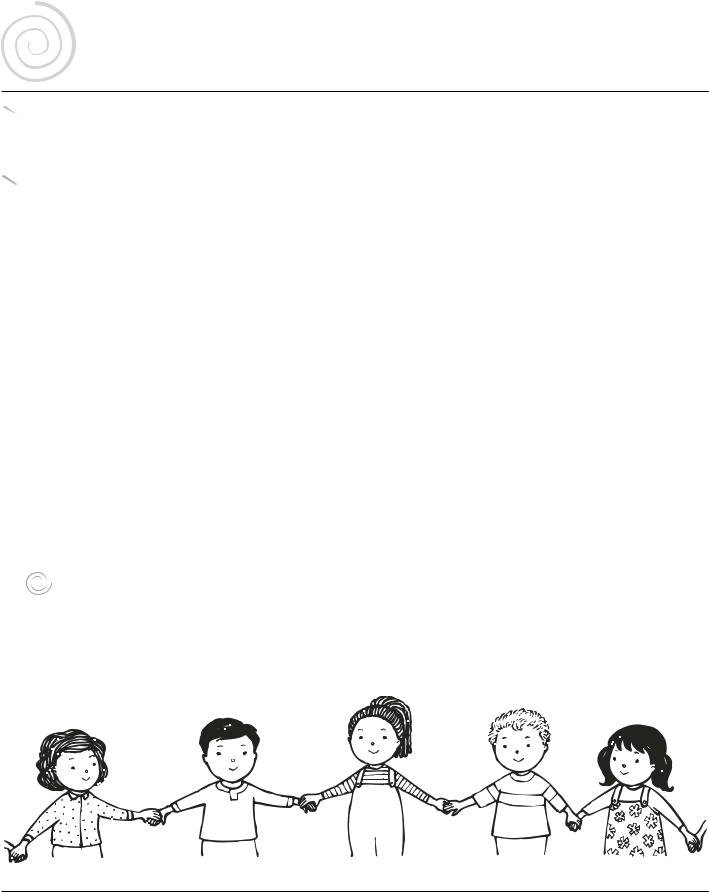
- •Table of Contents
- •Early Childhood
- •Introduction
- •Name Game
- •Up and Down
- •On the Outside
- •Rainbow Dolls
- •Responsible Me
- •The Mirror and Me
- •Positive Statements Poster
- •Talking Tube
- •The Circle of Noise
- •Happy Hands, Sad Hands
- •Feeling Faces
- •Knock, Knock
- •Friendship Ring
- •Language and Literacy
- •Wonder Why
- •What If?
- •How Many Ways?
- •Rhyming Riddles
- •Story Bag
- •Symbol Stories
- •Answers and Questions
- •Simon Says Opposites
- •Fun with Books
- •Nonverbal Communication
- •Words All Around Us
- •Alphabet Letter Magnets
- •Listen to the Sound
- •Math
- •Counting Song
- •Counting Catches
- •Number Match Game
- •Seasonal Number Rhyme
- •How Many?
- •Walk Around the Shape
- •Shapes in the Air
- •I Spy a Shape
- •Shape Bingo
- •Shape Dance
- •What Does It Weigh?
- •Lengthy Fun
- •Shape Patterns
- •Patterns in Sound
- •Science
- •People, Places, and Things
- •Same and Different
- •Bug in the Rug Game
- •Backwards Photos
- •Nature Walk Stories
- •Shadow Explorations
- •Buzz
- •The Fan Club
- •When We Were Small
- •What Is the Weather?
- •Time for Graphing
- •Sink or Float?
- •Qualities
- •Light Show
- •Music and Movement
- •Drumbeats Movement
- •Streamer Fun
- •Musical Instruments
- •Music Everywhere
- •High and Low
- •Music Detectives
- •Partners Move!
- •Moving with Scarves
- •Dance Fever
- •Visual Arts
- •Musical Collage
- •Puzzle Mural
- •Playdough Creation
- •Our Sculpture
- •Brick Building Mural
- •Sculpture Bags
- •Sticky Mural
- •Weaving Net
- •Chalk Pizza
- •Dramatic Play
- •Nursery Rhyme Fun
- •Space Adventure
- •Airplane Trip
- •Fly In and Out the Window
- •Pumpkin Patch
- •Row Your Boat
- •Mousy Moves
- •Sticky Story
- •Animals Sleeping
- •Football Practice
- •Motor Skills
- •Build a Tower
- •The Feather Dance
- •Fun with a Parachute
- •Beanbag Game
- •Hoops of Fun
- •Wading Pool Fun
- •Bubble Wrap Play
- •Dot-to-Dot Mural
- •The Friendship Squeeze
- •Musical Chairs and More
- •Moving with Carpet Squares
- •Walk the Line
- •Copycat

Social and Emotional Development
6 RESPONSIBLE ME
 Materials
Materials
Index card
Marker
 Activity
Activity
This activity introduces young children to the concept of responsibility and how it applies to them. Write the letter R on an index card. Show the children the card. Explain that the letter stands for the word responsibility. Say the word slowly and have everyone repeat it. Ask the children if they know what responsibility means. Help them brainstorm ideas. Encourage the idea that being responsible for something means that you take care of it.
Ask the children to think about the responsibilities they have as members of their families. Pass around the R card. As each child holds the card, have that child tell what he or she is responsible for taking care of at home. Possible answers include brushing teeth, picking up toys, making the bed, putting away clothes, or setting the table.
Teach the children the responsibility chant below. Have them clap out the rhythm. Say this chant frequently throughout the year.
Responsible me,
Responsible me,
Helpful as a honeybee.
Doing a job,
Doing my best,
Getting it done
Before I rest.
Responsible me,
Responsible me,
Helpful as a honeybee.
Jean Warren
Variation: Instead of talking about responsibilities as members of their families, have the children discuss their responsibilities as members of your group.
© School Specialty Publishing |
12 |
1-57029-486-0 101 Circle Time Activities |

Social and Emotional Development
7 THE MIRROR AND ME
 Materials
Materials
Hand mirror
Music
 Activity
Activity
Learn about one another with this informative group activity. Have the children sit in a circle. Give one child a hand mirror to hold. Begin playing some music and have the children carefully pass the mirror around the circle. Stop the music. Let the child who is holding the mirror answer a question about him or herself. Start the music again and continue playing the game, stopping and starting the music as needed until everyone has had a turn.
Variation: Instead of answering a question, have the child who is holding the mirror listen while classmates each tell one thing they like about him or her.
8 POSITIVE STATEMENTS POSTER
 Materials
Materials
Poster board
Markers
 Activity
Activity
Help the children practice positive statements with this activity. Hang a sheet of poster board on a wall. Invite the children to sit near the poster board. Ask them to think about the things they can say to help others feel happy. They could say:
You’re nice.
I’m glad we’re friends.
I like to play cars with you.
That’s a great picture you’re painting.
I like your playdough sculpture.
Write the children’s positive statements on the poster board as they say them. Talk about the power of positive statements to help get along with others, or to help make the day go well. Leave your positive statement poster on the wall as a reminder to everyone to make lots of positive statements every day.
© School Specialty Publishing |
13 |
1-57029-486-0 101 Circle Time Activities |

Social and Emotional Development
9 TALKING TUBE
 Materials
Materials
Cardboard tube
Crayons
 Activity
Activity
Waiting for your turn to speak is a challenge for young children, but a talking tube can make this task a little easier for them. Decorate a cardboard paper towel tube with crayons to make a talking tube and
show it to the children. Explain that this tube is similar to the Native
American talking stick. Some Native Americans used a talking stick whenever a group of people was gathered together. Only the person holding the stick could talk. Everyone else had to listen. Then the person holding the stick would hand it to the next person to talk.
Sit with the children in a circle. Hold the talking tube and say your name. Pass the tube to the child beside you and have that child say his or her name. Continue until each child has said his or her name. Then ask the children to think of their favorite thing to do. Pass the talking tube to one of the children and have him or her name a favorite activity. Have the other children who have not had a turn silently raise their hands. Let the child with the talking tube give it to a child with his or her hand raised. Repeat until each child has had a turn. After the children have practiced with the talking tube, you may wish to use it whenever you want to have a group discussion in which one person at a time may talk.
10 THE CIRCLE OF NOISE
 Materials
Materials
Yarn
Scissors
 Activity
Activity
Help the children learn to distinguish between inside noise and outside noise with this activity. Cut a 15foot length of yarn and arrange it on the floor in a circle. Have the children stand around the circle of yarn to make the “circle of noise.” Explain to them that you will be making quiet and loud noises. When you make a quiet sound (dropping a paper clip to the ground, tapping drinking straws together), have them stand inside the circle of noise. When you make a loud sound (beating on a drum, banging blocks together), have them stand outside the circle of noise. Remind them to make quiet sounds when they are indoors and to save their loud sounds for outside.
© School Specialty Publishing |
14 |
1-57029-486-0 101 Circle Time Activities |

Social and Emotional Development
11 HAPPY HANDS, SAD HANDS
 Materials
Materials
None
 Activity
Activity
Play this game after noticing the children fighting, hitting, pushing, or otherwise using their hands in inappropriate ways. Have the children stand in a circle. Begin with this rhyme:
Let’s hold hands and circle round.
(Hold hands in a circle and walk around.)
Now everyone, please sit down.
(Sit down.)
Place your hands in front of you
(Place hands in lap.)
And talk about what they can do.
Patty Claycomb
Explain to the children that “happy hands” are hands that do things to make others happy. “Sad hands” are hands that hurt others and make them sad. Have the children think of ways they use their happy hands such as waving, rocking a baby, holding a friend’s hand, or softly patting someone. Then ask them to think of ways to use sad hands such as pushing or shoving, throwing toys, grabbing a toy from someone else, or pulling on a stuffed animal. Ask the children which kinds of hands they would rather be around. Have them tell you ways to use happy hands today.
Extension: Cut hand shapes out of construction paper. Draw a happy face on half of the hand shapes and a sad face on the other half. Place the hand shapes on the floor, facedown. Let each child turn over a hand. If a happy face is showing, have the children name a way to use hands nicely. If a sad face is showing, let the child tell of a way that hands can hurt.
© School Specialty Publishing |
15 |
1-57029-486-0 101 Circle Time Activities |
